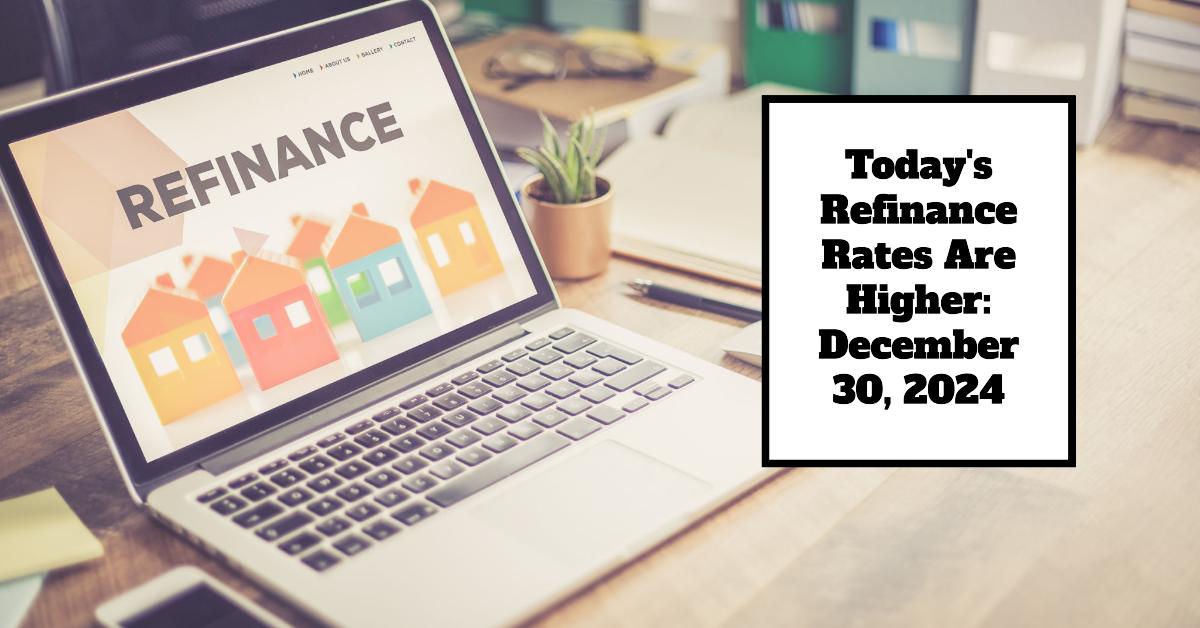If you're thinking about refinancing your mortgage, knowing today's refinance rates is crucial for making an informed decision. As of December 30, 2024, refinance rates have seen some fluctuations, with the current average rates standing as follows: 7.07% for a 30-year fixed-rate, 6.34% for a 15-year fixed-rate, and 6.28% for a 10-year fixed-rate loan. Despite the high rates compared to past years, refinancing might still be a smart choice under certain circumstances.
Today's Refinance Rates December 30, 2024: Should You Refinance?
Key Takeaways
- Current Average Rates:
- 30-Year Fixed Rate: 7.07%
- 15-Year Fixed Rate: 6.34%
- 10-Year Fixed Rate: 6.28%
- Refinance rates are higher this week, up by 0.11%, 0.13%, and 0.17% respectively for 30-year, 15-year, and 10-year loans.
- Most homeowners currently hold low-rate mortgages, making refinancing less appealing unless rates drop below 6%.
- Strong inflation and a shifting economic outlook are key factors behind the current rates.
An Overview of Today's Refinance Rates
Refinancing a mortgage means replacing your existing loan with a new one, and it often involves adjusting your interest rate and loan terms. Here’s a detailed look at the average refinance rates reported today by Bankrate:
| Loan Type | Average Rate | Change from Last Week |
|---|---|---|
| 30-Year Fixed Rate | 7.07% | +0.11% |
| 15-Year Fixed Rate | 6.34% | +0.13% |
| 10-Year Fixed Rate | 6.28% | +0.17% |
These rates reflect a trend that financial analysts have pointed out: the remnant effects of previous Federal Reserve policies paired with ongoing inflation concerns are keeping refinancing rates elevated.
Current Refinance Rate Trends
Entering 2024, many had expectations that inflation would decline, leading to lower refinance rates. However, the reality is more complex. Changes in labor market conditions and unexpected inflation have resulted in higher rates instead. The ongoing uncertainty in the political landscape, especially with new economic policies expected from the recent presidential administration, has further contributed to rising rates.
Interest Rate Dynamics: The Federal Reserve influences the broader economic climate by adjusting interest rates. A lower rate typically stimulates the economy, while a higher rate cools it down. As activities in the housing market remain subdued, refinancing may not serve as an appealing option for many homeowners, especially those with existing favorable mortgage rates.
What to Expect in 2025
The future of refinance rates remains uncertain. Experts speculate that while rates may drop to around 6.5% or lower, the overall activity in housing may still be limited. The Fed's “wait-and-see” approach indicates a potential flattening of rates, depending on upcoming inflation and employment data.
Understanding the Economic Forecast: Economists have varying predictions about inflation and employment trends for the upcoming year. Some are optimistic about gradual improvements, while others warn of persistent economic volatility. If inflation continues to rise, the Fed may hold off on cutting rates, leading to a stagnant increase in mortgage costs.
The Basics of Refinancing
When homeowners consider refinancing, it involves several key components, including understanding the difference between types of loans and the implications for their financial situation.
Types of Refinancing Options
- Traditional Refinance: This replaces your current mortgage with a new one at a different interest rate and/or term length. This is the most common type of refinancing where the focus is usually reducing monthly payments.
- Cash-Out Refinance: This option enables you to borrow against the equity in your home, potentially allowing you to access significant cash for renovations, debt consolidation, or other large purchases. In essence, you'll be taking out a larger loan than what you currently owe on your property.
Current Economic Factors Impacting Refinance Rates
Mortgage rates are influenced not only by the Federal Reserve's actions but also by broader economic conditions, including:
- Inflation Rates: Continuing inflation pressures compel rates to increase as lenders seek to maintain profit margins. We saw several instances throughout 2024 where inflation data consistently surprised analysts, leading to reassessments of interest rates.
- Labor Market: Strength in the job market may signal further inflation, leading to an uptick in interest rates. The Fed's dual mandate of maximizing employment and stabilizing prices means that significant changes in employment data might influence their decisions.
- Political Climate: Investors remain cautious based on potential governmental economic policies that may affect inflation and debt. The recent electoral outcomes and anticipated policies implemented by the new administration have created an air of uncertainty that continues to affect the mortgage market.
Comparative Refinance Costs and Calculations
To give you a clearer picture of how refinancing today affects your finances, let’s analyze a few scenarios based on common loan amounts.
Imagine a homeowner considering refinancing a $340,000 mortgage:
| Loan Type | Current Average Rate | Previous Average Rate | Loan Amount | Monthly Payment (Approx.) | Total Interest Paid (Approx.) |
|---|---|---|---|---|---|
| 30-Year Fixed | 7.07% | 3.29% | $340,000 | $2,268 | $297,868 |
| 15-Year Fixed | 6.34% | 2.63% | $340,000 | $2,386 | $75,657 |
| 10-Year Fixed | 6.28% | 2.54% | $340,000 | $4,030 | $37,711 |
The stark differences illustrate the higher costs associated with refinancing at today’s rates compared to historical lows seen during the pandemic.
Breaking Down the Costs
- Monthly Payments: The monthly payments increase significantly with higher rates.
- Total Interest: Over the life of the loan, homeowners who refinance today might face much higher total interest costs, especially for extended terms like the 30-year fixed options.
Finding the Best Refinancing Rates
If refinancing still seems viable for your financial situation, consider these strategies to maximize your benefits:
- Evaluate Your Credit Score: A higher credit score leads to better interest rates. Ensure your credit report is accurate and that you’ve addressed any potential issues.
- Shop Around: Different lenders offer varying rates, so it’s worthwhile to compare multiple options. Services and rates can change quickly, so stay informed.
- Monitor Market Trends: Keep an eye on the rates as they can fluctuate, and timing your refinance can lead to substantial savings.
Future Developments in Mortgage Rates
As we transition into 2025, homeowners should prepare for continued unpredictability in the mortgage market. Analysts are divided on how the Fed's policy changes will play out and how that will influence refinancing opportunities. Some suggest that if inflation eases significantly, we may see a gradual return to lower refinancing rates by mid to late 2025.
Summary:
In essence, today's refinance rates reflect broader economic realities. With 7.07% for 30-year fixed loans, the options might seem less appealing for many homeowners, especially those with older, lower-rate mortgages.
Understanding the nuances of refinancing, current trends, and economic factors can help navigate your choices. Always take the time to research and evaluate if refinancing aligns with your financial goals.
Work with Norada in 2025, Your Trusted Source for
Turnkey Investment Properties
Discover high-quality, ready-to-rent properties designed to deliver consistent returns.
Contact us today to expand your real estate portfolio with confidence.
Contact our investment counselors (No Obligation):
(800) 611-3060
Recommended Read:
- Should I Refinance My Mortgage Now or Wait Until 2025?
- When You Refinance a Mortgage Do the 30 Years Start Over?
- Should You Refinance as Mortgage Rates Reach Lowest Level in Over a Year?
- NAR Predicts 6% Mortgage Rates in 2025 Will Boost Housing Market
- Mortgage Rates Predictions for 2025: Expert Forecast
- Half of Recent Home Buyers Got Mortgage Rates Below 5%
- Mortgage Rates Need to Drop by 2% Before Buying Spree Begins
- Prediction: Why Mortgage Rates Won’t Go Below 6% in 2024?
- Will Mortgage Rates Ever Be 3% Again: Future Outlook
- Mortgage Rates Predictions for Next 2 Years
- Mortgage Rate Predictions for Next 5 Years



